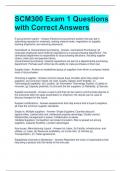SCM300 Exam 1 Questions
with Correct Answers
E-procurement system - Answer-Electronic procurement system that can aid in
submitting requests for materials, making material order, negotiation w/ supplier,
tracking shipments, and receiving shipments.
Centralized vs. Decentralized purchasing - Answer--Centralized Purchasing: all
corporate employees send material requisitions to a sing purchasing department. The
centralized department is responsible for all purchasing decisions, including supplier
choice, order size and payment terms.
-Decentralized purchasing: material requisitions are sent to a departmental purchasing
department. Perhaps each office has the ability to make purchases of their own.
Supplier base - Answer-an established group of suppliers from which a company makes
most of its purchases.
Choosing a supplier - Answer-common issues buys consider when they weigh now
suppliers: (a) Consumer needs, (b) Cost, Quality, Speed, and Flexibility, (c)
Technological capability, (d) Location, (e) Information Technology System, (f) ability to
innovate, (g) Capacity potential, (h) 2nd and 3rd tier suppliers, (i) Reliability, (j) Service.
Supplier scorecards - Answer-a report card that can be used to communicate desires or
the outcomes after the sales presentation or shipment, the results can be used to
discuss changes for the future.
Supplier certifications - Answer-assessments that help ensure that a buyer's suppliers
all meet the minimum supplier standards.
Single vs. Multiple suppliers - Answer--Single Suppliers: Quantity discount
opportunities, Lowest total cost, intellectual property advantage, Quality control,
Relationship management is easier, Collaboration is easier.
-Multiple Suppliers: Competition can breed innovation, Risk is spread out among
suppliers, Capacity flexibility. Location advantages
Key issues, Manufacturing Layout - Answer-(a) Labor, (b) Facility, infrastructure, and
utilities, (c) Laws, (d) Resource availability, (e) Local risks, (f) Climate (g)
Transportation, (h) Trade agreements
Established channels of distribution - Answer-Represent the chain of organizations that
help bring a product into the hands of the end user.
, Established supplier base - Answer-Implies that an organization has a group of
companies with which they have developed a working relationship.
Hypercompetitive markets - Answer-An industry that is heavily concentrated in a
particular region, where the companies compete fiercely.
Relationship... Marketing Design, SCM - Answer-All three departments must work
together as a team to market, create, and manufacture products that are good and will
be valued by the customer.
Strategic, Design, Operation - Answer--Strategic Decision: provide direction for the
company by identifying target markets, business models, and potentially product or
service categories in which the company would like to compete.
-Design Decisions: seek to satisfy a target market in a particular product or service
category.
-Operation Decisions: impact the organization in the SHORT-TERM, usually relate to
daily operations that are performed in a company on a routine basis.
Line Flow - Answer-manufacturing strategy and layout that typically works well in
producing end items that have relatively high demand and that require very little
customization. (Types: assembly line and continuous flow system)
Flex Flow - Answer-typically works well for producing end items that have relatively low
demand levels and that may require a high level of customization.
Hybrid Flow - Answer-combines elements of both line flow and flexible flow layouts.
GT Cell (Group Technology) - Answer-- type of hybrid strategy that utilizes a line-flow
layout for low-volume processes
- uses hybrid line flow
OWMM (One worker, Multiple Machines) - Answer-a line-flow layout that is designed to
be operated by a single employee.
Fixed Position Layout - Answer-layout type is used for very large and hard to move
items (e.g. airplanes, cruise ships, office buildings)
Assembly line challenges - Answer-(a) Bottlenecks (Slowest area of assembly line)
(b) Too many employees and/or workstations
(c) Employee inequities
(d) Present need versus future demands
Supply Chain Management (SCM) - Answer-the effective and efficient integration of the
suppliers, manufacturers, transportation organizations as well as the other parties
responsible for collectively bringing products and services to market.




